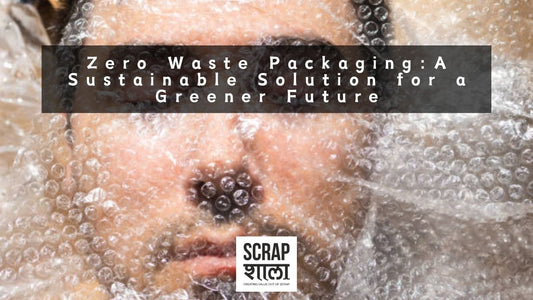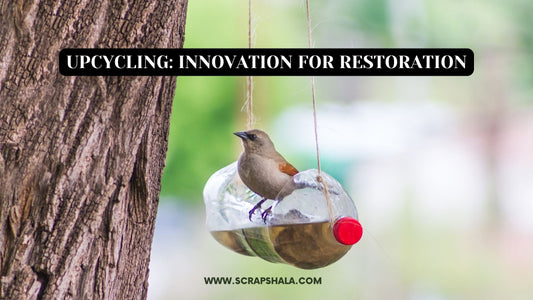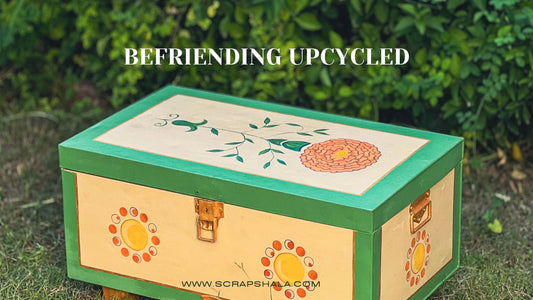The world is becoming increasingly aware of the impact of our consumption patterns on the environment. As a result, upcycling has become an increasingly popular way to repurpose and reuse household items that would otherwise end up in landfills.
Upcycling involves taking an old or unwanted item and transforming it into something new and useful. Not only does upcycling reduce waste, but it also offers a range of environmental benefits that are worth exploring. And that’s what we practice at Scrapshala too.
Reduces Waste: One of the primary benefits of upcycling is that it helps to reduce waste. According to the Environmental Protection Agency, Americans generate 292.4 million tons of waste each year, of which 69 million tons are recycled and 146 million tons end up in landfills. By upcycling, we can reduce the amount of waste that ends up in landfills and contribute to a more sustainable future.
By repurposing old or unwanted items, we can extend their lifespan and prevent them from becoming waste. This, in turn, reduces the demand for new products, which require energy and resources to produce, package, and transport.
Reduces Energy Use:Another environmental benefit of upcycling is that it reduces energy use. The production of new products requires energy, resources, and raw materials. This energy use contributes to greenhouse gas emissions and climate change.
By upcycling, we reduce the need for new products, which in turn reduces the energy required to produce and transport those products. For example, turning an old t-shirt into a quilt requires less energy than producing a new quilt from scratch.
Reduces Pollution:The production of new products also contributes to pollution. For example, the production of plastic products requires the use of fossil fuels and produces greenhouse gas emissions. Plastic waste is also a major environmental problem, as it can take hundreds of years to decompose and often ends up in the ocean, harming marine life.
By upcycling, we can reduce the demand for new plastic products, which in turn reduces the amount of pollution produced during the production process. Upcycling also reduces the amount of waste that ends up in landfills, which can release pollutants and greenhouse gases into the environment.
Preserves Resources:Upcycling also helps to preserve resources. The production of new products requires the use of raw materials, such as timber, minerals, and metals. These resources are finite, and their extraction can have a significant environmental impact.
By upcycling, we reduce the demand for new products and the resources required to produce them. This, in turn, preserves natural resources and reduces the environmental impact of their extraction.
Encourages Creativity:In addition to the environmental benefits, upcycling also encourages creativity. Upcycling allows us to explore our creativity and turn old or unwanted items into new and unique creations. This not only gives us a sense of satisfaction but also reduces the demand for new, mass-produced items that lack character and personality.
Upcycling also encourages us to think about the potential of materials and items that we might otherwise throw away. By using our imaginations and exploring different possibilities, we can transform old or unwanted items into something new and useful.
Reduces Carbon Footprint:Another environmental benefit of upcycling is that it reduces our carbon footprint. Our carbon footprint refers to the number of greenhouse gases that are emitted because of our activities. The production of new products requires energy and resources, which contributes to greenhouse gas emissions and climate change.
By upcycling, we reduce the demand for new products and the energy required to produce them. This, in turn, reduces our carbon footprint and contributes to a more sustainable future.
Provides Economic Benefits:Finally, upcycling can also provide economic benefits. Upcycling can be a cost-effective way to create new and useful items without having to buy new products.
In conclusion, upcycling offers a range of environmental benefits that are worth exploring. By reducing waste, energy use, pollution, and the demand for new products, upcycling can contribute to a more sustainable future. Additionally, upcycling encourages creativity, reduces our carbon footprint, and can provide economic benefits. So, the next time you're considering throwing away an old or unwanted item, consider upcycling it instead. You might be surprised at the possibilities and the positive impact it can have on the environment.
As an upcycling company, Scrapshala plays an important role in promoting sustainable practices and reducing waste. The company specializes in upcycling various household and industrial waste into unique and innovative products, such as furniture, decor, and accessories.
By upcycling waste materials, Scrapshala reduces the amount of waste that ends up in landfills and contributes to a more sustainable future. The company also provides an opportunity for individuals and businesses to practice circularity by getting their scrap repurposed into high quality products in an environmentally friendly manner.
In summary, as an upcycling company, Scrapshala helps to promote sustainability, reduce waste, encourage creativity, and provide economic benefits. By supporting upcycling companies like Scrapshala, we can all contribute to a more sustainable and responsible future.





















2 comments
Fantastic Work eco friendly products in raipur
We can all contribute to a sustainable future by choosing eco-friendly products in Raipur for a responsible lifestyle.eco friendly products in raipur